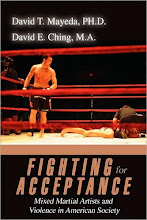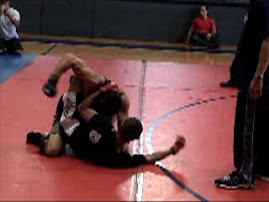 [Cross-posted on FightTicker.com]
[Cross-posted on FightTicker.com]Today, the Ultimate Fighting Championship (UFC) will hold its centennial event, UFC 100. Mixed martial arts (MMA) has become the "ultimate" in what I have termed fight sport theater--the marketing and presentation of fighting for popular consumption, and UFC 100 is truly a milestone event for the sport.
As a 36-year-old male with an athletic background, I'm within close range of their target demographic, males ages 18-34. Perhaps not surprisingly, I have been successfully seduced by the sport's athleticism, machismo, and overall theatrical presentation of violence.
Yet as a scholar, who dissects the intricacies of youth violence incessantly, I am also one of the sport's major critics. Our society glorifies violence on so many levels, frequently using violence and interpersonal domination to embolden a type of masculinity that creates societal problems daily (see here for a latest example).
Relative to the massive collective violence we see encapsulating the Middle East and Africa, or the examples of gun, family, street violence and other types of crime that occur regularly in the west, sporting violence is a blip on the radar. Truthfully, MMA is merely a small part of our culture that accepts violence in everyday life. Yet is it acceptable to justify violence by comparing it to other, more excessive forms (e.g., MMA is far less dangerous than boxing, let alone war)?
So what does it mean, that the UFC has been able to successfully push the ultimate in fight sport theater through 100 shows and mesmerize its largely male audiences for 16 years? What does it mean to have athletes like B.J. Penn who strategically demeans opponents through verbal barrages of expletives to push his fights, a reality show that trivializes bullying, or a company president who says to a female sports reporter, “…you f’n dumb bi--h”?
Or what does it mean to have incredibly diverse athletes like Lyoto Machida, Anderson Silva and Georges St. Pierre, from countries outside of the United States, who are UFC champions exemplifying the very traditional notions of martial arts that respect competition?
I think we’re all still trying to figure it out. For better or worse, enjoy the fights. Admittedly, I will.









It would be interesting to explore why "the sport's athleticism, machismo, and overall theatrical presentation of violence" is appealing.
ReplyDeleteThat's definitely one of the fundamental questions. For me, I'm pretty sure it's about my youthful socialization into violent sports through media and peers, which ultimately glorified and normalized sporting violence.
ReplyDeleteHow that kind of masculine socialization through sport began is up for debate, but a number of scholars have said it stems from a reaction to women's push for suffrage and industrialization out of "manly" farm work back at the turn of the century.
Interesting theory to its origins. However, I would expect it might be more ancient. Consider the gladiators. Of course, they seemed to be popular with both genders.
ReplyDeleteYeah, definitely, that's just what I've read on the modern era of sports. The books I'm thinking of are _Power at Play: Sports and the Problem of Masculinity_ by Messner and _Coming on Strong: Gender and Sexuality in Twentieth Century Women's Sport_ by Cahn. They're both excellent texts.
ReplyDeleteUnfortunately, I haven't read anything that covers the period you're referring to, but looking into that era would be super interesting to see what overlap exists with contemporary attitudes on masculinity and sporting violence.